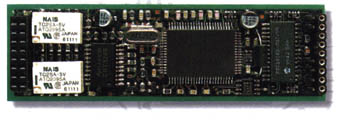Pablo-IV Video Encoder Module

-- Driver Software Updates --
Until now, you could only view the Picasso IV video output on your computer monitor. This is going to change with the Pablo IV which encodes the
video signal, making it suitable for use with VCRs, television sets and studio equipment. In particular, this allows for video titling and recording
animations to tape.
Features:
The video signal the Pablo IV generates must match your local television standard, such as NTSC or PAL. Four of these standards are supported:
- NTSC
- NTSC-EIA (the NTSC variant used in Japan)
- PAL B, G and I
- PAL M (a 60 Hz variant of PAL)
The Pablo IV plugs into the PicassoIV board and delivers its video signal at the S-VHS video output connector described in the PicassoIV manual.
You are not restricted to use an S-VHS video signal; the Pablo IV can be switched into CVBS (Composite) video mode. However, you need a special
adaptor to connect the CVBS cable to the S-VHS video output connector (supplied with the Pablo IV).
The Pablo IV can encode one basic screen resolution (640x480) into a video signal. This resolution is slightly smaller than the display would allow.
An overscanned screen resolution (800x600) is available in PAL B/G/I mode which covers the entire display.
Due to how video signals are encoded for display on a television set, some flicker is unavoidable (you may remember this from the last time you
connected your Amiga to your tv set). The Pablo IV can reduce the flicker of the signal it generates by using a technique known as linear interpolation.
Requirements:
The PabloIV plugs into the PicassoIV, which is absolutely required for operation.
The PicassoIV firmware may need updating in order to recognize the Pablo IV and allow it to be used. Firmware version 4.1 or higher is
required, which depending on when your PicassoIV was manufactured might already be installed.
Limitations:
- Only four television standards are supported, SECAM and its variants are not among them. If you require SECAM output we suggest you use a signal
converter which is available from specialist dealers.
- The Pablo IV delivers either an S-VHS or a CVBS (Composite) video signal. These signals are not compatible with the antenna jack of your
television set or VCR. You can connect the PicassoIV video output port only to jacks labeled "S-VHS", "Y/C IN", "S-VIDEO IN" or "VIDEO IN".
An AV-Euroconnector (also known as "SCART") may be suitable, but would require an adaptor.
- Only two display sizes are suitable for use with the Pablo IV. These are 640x480 and 800x600 (the latter available only in PAL B/G/I mode).
Any other size will produce only a black picture. Due to how the display size is specified in the television standards, the actual size of the
screen may be a few pixels smaller in the horizontal direction.
- The video signal generated by the Pablo IV cannot be fed directly into a studio timer or genlock, you would need a time base corrector for this
purpose.
Other Add-Ons:
As a companion for the Pablo IV, Village Tronic makes the Paloma video input module for the PicassoIV. Among other features, the Paloma allows
video signal input to be captured. The captured signal can be combined with computer generated graphics. The result can then be fed into the
Pablo IV thus producing a digital genlock.
Contens of package:
The Pablo IV package contains the following items:
- Pablo IV board
- S-VHS to CVBS adaptor cable
- Manual (German/English)
- One installation disk
- Registration card
Supplied software:
As of this writing, the Pablo IV ships with the following software:
- Pablo IV Prefs which is an preferences program to configure your Pablo IV board and save the settings to the PicassoIV Flash ROM.
 Show big snapshot!
Show big snapshot!
- PicassoMode TNG is also included and allows the user to choose the desired screenmodes to be encoded.
Last updated: 05th November 1997
Copyright ©`1997 by Village Tronic GmbH
Webdesign © by Jens Langner
